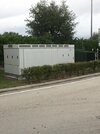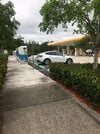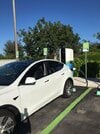I use 300-400KW of energy for home charging per month. Take your electricity rate and calculate the $ number.For those that persistently charge at home using the Tesla Wall Charger (we're waiting on delivery of our MY later this month and are having a Tesla Wall Charger installed soon) how much have you seen your electric bill increase on a monthly basis? I realize rates are different in every state and power company dependent - but am curious on average what to expect.
Welcome to Tesla Motors Club
Discuss Tesla's Model S, Model 3, Model X, Model Y, Cybertruck, Roadster and More.
Register
Install the app
How to install the app on iOS
You can install our site as a web app on your iOS device by utilizing the Add to Home Screen feature in Safari. Please see this thread for more details on this.
Note: This feature may not be available in some browsers.
-
Want to remove ads? Register an account and login to see fewer ads, and become a Supporting Member to remove almost all ads.
You are using an out of date browser. It may not display this or other websites correctly.
You should upgrade or use an alternative browser.
You should upgrade or use an alternative browser.
Where do you charge your Model Y to for daily use?
- Thread starter YNoVA
- Start date
zman19
Member
It will depend on how hard you drive the car and how far. Figure around 1/4-1/3 of whatever you were spending on gas.For those that persistently charge at home using the Tesla Wall Charger (we're waiting on delivery of our MY later this month and are having a Tesla Wall Charger installed soon) how much have you seen your electric bill increase on a monthly basis? I realize rates are different in every state and power company dependent - but am curious on average what to expect.
Home charging costs would only depend on your cost per kWh and how many miles you drive per month or per year.For those that persistently charge at home using the Tesla Wall Charger (we're waiting on delivery of our MY later this month and are having a Tesla Wall Charger installed soon) how much have you seen your electric bill increase on a monthly basis? I realize rates are different in every state and power company dependent - but am curious on average what to expect.
First, look at a recent electric utility bill and divide the total charges ($) by the number of kWh consumed for the billing period. This will tell you your cost per kWh including all taxes, tariffs and any add-on fees.
Estimate your weekly, monthly or annual miles driven. Typically this is right around 30 miles per day, 900 miles per month or ~11,000 miles per year.
Using 270 Watt hours per mile (0.270 kWh/mile), a value that is neither particularly efficient or inefficient and accounts for seasonal increase in energy usage in winter, you can determine how many kWh you will use per month and per year. Example: 900 miles * 0.270 kWh/mile = 243 kWh. If you determine that your cost per kWh is $0.15 then you could expect your utility bill to increase by ~$36.50. You can also estimate your cost per mile (for electricity) at $36.50 / 900 miles = $0.04 per mile. Not included in this energy cost is the cost of preconditioning while the Tesla Model Y is parked (preconditioning can also activate battery warming when the battery is cold.) So while your cost per mile for driving might be $0.04 per mile when you add in the cost of preconditioning it could be a bit more than ~$0.05 per mile.
Last edited:
FatherTo1
Active Member
We live in Northern California and drive 2,000 miles a month, with average monthly charging cost of $54 (about 2.7 cents per mile). Electricity rates in our area have gone up 30-40% since 2019 but night-time off-peak only went up 10% (2.4 cents per mile back in 2019).For those that persistently charge at home using the Tesla Wall Charger (we're waiting on delivery of our MY later this month and are having a Tesla Wall Charger installed soon) how much have you seen your electric bill increase on a monthly basis? I realize rates are different in every state and power company dependent - but am curious on average what to expect.
Last edited:
HitchHiker71
Member
Of course a lot depends on how far you drive and how often you drive - my average bill increased about $22 a month. A little bit higher in the summer, because we do more traveling in the Summer
Thanks - this will be my wife's first EV. Her round trip daily work commute is approximately 45 miles - so I figure 50 miles per day average with other errands while coming home from work. Figure fewer daily miles on the weekends, probably 20-15 miles per day on average. So roughly 350 miles per week.
HitchHiker71
Member
Home charging costs would only depend on your cost per kWh and how many miles you drive per month or per year.
First, look at a recent electric utility bill and divide the total charges ($) by the number of kWh consumed for the billing period. This will tell you your cost per kWh including all taxes, tariffs and any add-on fees.
Estimate your weekly, monthly or annual miles driven. Typically this is right around 30 miles per day, 900 miles per month or ~11,000 miles per year.
Using 270 Watt hours per mile (0.270 kWh/mile), a value that is neither particularly efficient or inefficient and accounts for seasonal increase in energy usage in winter, you can determine how many kWh you will use per month and per year. Example: 900 miles * 0.270 kWh/mile = 243 kWh. If you determine that your cost per kWh is $0.15 then you could expect your utility bill to increase by ~$36.50. You can also estimate your cost per mile (for electricity) at $36.50 / 900 miles = $0.04 per mile. Not included in this energy cost is the cost of preconditioning while the Tesla Model Y is parked (preconditioning can also activate battery warming when the battery is cold.) So while your cost per mile for driving might be $0.04 per mile when you add in the cost of preconditioning it could be a bit more than ~$0.05 per mile.
Roughly 250 miles for daily workday commute plus figure 25 miles per day on weekends - or roughly 300 miles per week on average.
Our latest power bill from February 2023, math as follows:
$339.26 / 2583 = 13.13/KwH
300 *4.3 = 1290 miles per month on average
1290 * 0.270 KwH/mile = 348.3 KwH
348.3 * .1313 = $45.73 per month electric charges on average. Figure $3.20/gallon on gas in our area on average for regular. $165.12 per month on gas for those same miles.
$45.72 / 165.12 = 0.28 or 28% of the cost of gas per month - so we're saving 72% on fuel per month on average if my math is right here.
HitchHiker71
Member
I use 300-400KW of energy for home charging per month. Take your electricity rate and calculate the $ number.
Well, according to the math I just did - we're right in the midst of that range at 348KwH. We'll have to see how the real world numbers turn up but the math is good enough for now.
You are currently spending ~12.8 cents per mile for gas not including oil and filter changes versus 3.5 to 4.5 cents per mile for electricity. 3.5/12.8 = 28%; 35% @ 4.5 cents per mile (includes additional cost for the electricity used over 5 to 10 minutes to precondition (warm up) the Tesla Model Y passenger cabin and battery before starting to drive.)
BitJam
Active Member
69%Tesla recommends to charge up to 80-90% for daily use. I personally set my charge limit to 80% on my MYP. What do you set your charge limit to?
Dale_L
Member
I charge at home. I use the Tesla J1772 plug adapter with an EVoCharge, 32 Amp, 240V, Level 2 EV Charger. I bought and installed the EVoCharge in 2018 to charge my 2018 Honda Clarity PHEV. (I traded in the Clarity on 1/21/2023 when I bought my MYLR.)
For everyday driving, I set the charge limit to 65% to 75% depending on my mood and/or how much driving I expect to do the next day.
Electricity here in Florida is 13 cents a kilowatt. (Cheap)
For everyday driving, I set the charge limit to 65% to 75% depending on my mood and/or how much driving I expect to do the next day.
Electricity here in Florida is 13 cents a kilowatt. (Cheap)
I have not seen an increase in my bill. Took advantage of my util's EV rate. They came out and swapped my electric meter to a TOU meter. KWH went up but cost stayed the same. According to Tesla app, it has cost me $40 total to charge the Y since early February.For those that persistently charge at home using the Tesla Wall Charger (we're waiting on delivery of our MY later this month and are having a Tesla Wall Charger installed soon) how much have you seen your electric bill increase on a monthly basis? I realize rates are different in every state and power company dependent - but am curious on average what to expect.
Charge limit varies between 50 and 90 percent depending on solar and grid CO2 intensity conditions. Charge faster and deeper when it's cleaner, let it float down when the wind dies, etc. HomeAssistant + OpenEVSE make this pretty trivial to accomplish.
HitchHiker71
Member
I have not seen an increase in my bill. Took advantage of my util's EV rate. They came out and swapped my electric meter to a TOU meter. KWH went up but cost stayed the same. According to Tesla app, it has cost me $40 total to charge the Y since early February.
Unfortunately my electric utility provider does not offer a TOU plan without swapping out the meter - which they won't assist with any funding - total out of pocket is on the customer - which is $400 for the new meter, plus all applicable installation charges around $1000. Our TOU EV rate (called the PIV rate) also isn't much lower than our off-peak rates - so we would only see savings of $3-5 per month best estimate - this estimate is from the utility provider not me - which means we wouldn't see breakeven for $1400/5 = 280 months or 23 years. Not worth it from a ROI standpoint - not even close.
h2ofun
Active Member
I charge at home with one of my 5 Tesla Wall connectors. 80% to like 30%, depending on what is needed the next day.
When sunny, I produce about 20kw of solar which gets my 7 PW's charged around noon. I then turn on the EV charging since would rather use my solar, then send back to PGE.
When sunny, I produce about 20kw of solar which gets my 7 PW's charged around noon. I then turn on the EV charging since would rather use my solar, then send back to PGE.
howardnj
Member
When I am in Florida, I prefer to use the FPL Evolution 350 kWh chargers using my CC1 adapter. They charge faster and are cheaper than the Tesla 250 kWh chargers. They are 3 phase 13,200 volt AC to DC chargers.
Attachments
When I am in Florida, I prefer to use the FPL Evolution 350 kWh chargers using my CC1 adapter. They charge faster and are cheaper than the Tesla 250 kWh chargers. They are 3 phase 13,200 volt AC to DC chargers.
Are you seeing faster than 250kw? Is the charge curve different throughout the charging session?
howardnj
Member
The initial charge rate varies depending on the beginning SOC and if I remembered to allow enough time for battery preconditioning prior to arrival. It usually starts out over 100kwh and declines as the battery SOC increases.Are you seeing faster than 250kw? Is the charge curve different throughout the charging session?
The initial charge rate varies depending on the beginning SOC and if I remembered to allow enough time for battery preconditioning prior to arrival. It usually starts out over 100kwh and declines as the battery SOC increases.
That's interesting. I have actually hit 250kW on the Tesla Superchargers when my arriving SOC is around 20%. Typically it will stay above 100 kW for quite a while.
The initial charge rate varies depending on the beginning SOC and if I remembered to allow enough time for battery preconditioning prior to arrival. It usually starts out over 100kwh and declines as the battery SOC increases.
100 is not more than 250. Your math does not check out
It's very likely less expensive, though.
How much did you pay for your adapter? I wonder how long it would take to break even using the cheaper charger with the purchased adapter.
Similar threads
- Poll
- Replies
- 61
- Views
- 2K
- Replies
- 2
- Views
- 719
- Replies
- 0
- Views
- 331
- Replies
- 11
- Views
- 864
- Replies
- 6
- Views
- 756






